Creative Combustion: Image, Imagination and the Work of Robert Fulton
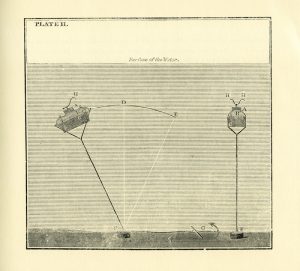
Between 1797 and 1806, artist and engineer Robert Fulton (1765–1815), better known for his career as a steamboat entrepreneur, was almost wholly preoccupied with the planning and promotion of a system for submarine and torpedo warfare. With the Napoleonic Wars playing out in the background, Fulton imagined seeding harbor beds on both sides of the Atlantic with hundreds of submerged mines (fig. 1)—what he called “torpedoes”—and even delivering these torpedoes directly to enemy boats via a submersible vessel and/or harpoon (fig. 2). Arguing that the threat of undetectable attack could finally end maritime warfare, he promoted the system as a means to secure “the liberty of the seas” and “the happiness of the earth.”1 In spite of such optimism, the project was ultimately unsuccessful. Fulton failed again and again to find a market for his work, searching first in France, then in England, and finally in the United States. However, the extraordinary lengths to which he went to see the project put into practice left behind a substantial documentary record, brimming with insights into the relationship between art and invention in the early nineteenth-century.
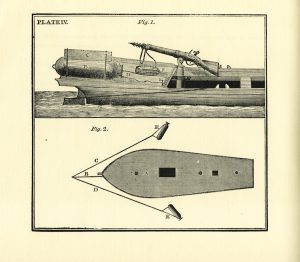
Among this record are two portraits of the inventor, the first produced by his friend and occasional mentor Benjamin West (1738–1820) (fig. 3). This 1806 painting offers a romantic picture of the forty-one year old engineer that unmistakably links the explosive activity of his torpedoes (seen here in the background) with what one of Fulton’s eulogizers would later call “the fire of his own genius.”2 The second image offers an instance of Fulton’s own self-fashioning—a self-portrait found amid the technical drawings detailing his submarine design (fig. 4). The drawing depicts the conical glass sections inserted into the conning tower of the submarine. These permitted ambient light into the vessel interior and allowed its captain to visually chart a course without emerging from the hatch. Measured and precise, with the author’s head neatly encased within an apparatus of his own devising, the drawing presents a mechanistic depiction of both inventor and the process of invention that appears very different from the dynamic picture of a brooding genius executed by West. A comparison of these two seemingly contradictory images offers the opportunity to explore from within, early nineteenth-century ideas about the technical imagination—a term used here to describe the engineer’s deeply intertwined processes of invention and representation. It also allows us to connect and contrast this technical imagination with the figure of the artistic genius more familiarly theorized in romanticism.3 As part of her broader project on objectivity, Lorraine Daston has charted the progressive polarization between art and science in this period and the simultaneous “migration of imagination to the artistic pole.”4 The professional engineer, a new occupation in the eighteenth century, sits uneasily between the practices of art and science, and both West’s portrayal of Fulton and the engineer’s own act of self-portraiture can best be understood as attempts to use the figure of the engineer to work through the complexities of this emergent dichotomy.

West’s portrait of Fulton juxtaposes the figure of the gentleman-inventor—neatly attired and minimally adorned—with a background scene illuminated by the explosive energy of his new invention. The relaxation of his pose—legs crossed, an arm swung easily over the back of his chair—operates counter to the intensity of his gaze and the coiled clasp of his hands. As an image of the technical imagination, this portrait resides somewhere between Mason Chamberlin’s 1762 portrayal of Benjamin Franklin (fig. 5) and West’s own highly allegorical depiction of Franklin Drawing Electricity from the Sky, painted circa 1816 (fig. 6). Chamberlin’s portrait presents Franklin as a staid figure, his gaze turned away from the extraordinary events outside and instead focused on the brass instruments to his right—instruments that could distill nature’s violent electrical outbursts into a set of visible and sonorous data points. It is an image of genius mediated by laboratory devices. The more dynamic portrayal by West depicts Franklin actively conducting an electric charge out of the sky and into his outstretched fist, as though the polymath’s extraordinary genius could be fed directly by the storm’s perilous lines of “electrical fluid.”5
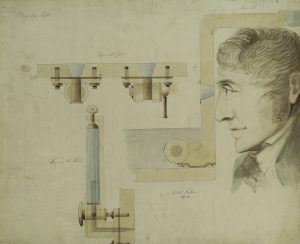
Produced a decade earlier than West’s painting of Franklin, the Fulton portrait is far more sober, relying on many of the same conventions seen in the Chamberlin depiction. Yet, the intensity of Fulton’s gaze and the luminescence of his face and hands suggest that the violent energy of West’s later portrayal is not absent here, but merely sublimated—restrained by gentlemanly trappings and redirected into the explosive effects of his subject’s work. West’s treatment of the face is particularly fascinating in this respect. The devilish halo of hair that surrounds Fulton’s head repeats at nearly a one-to-one scale in the plumes of smoke that emanate from the splintered ship. The glint of light off his nose and eyes and the brilliant glow of his forehead find their counterparts in the shooting flames of the wreck, receding into the distance.

The painting, however, is as notable for what it obscures as for what it illuminates. In the ten years that Fulton pursued the project, he proposed several different plans for torpedo warfare, all more akin to submerged mines than the self-propelled models we think of today. One, seen in an 1804 drawing, packed 200 pounds of powder and 150 to 180 bombs—what Fulton called “engines” or “combustible balls”—into a seven foot long watertight case made of three-inch-thick oak (fig. 7).6 The torpedo was ignited by a clockwork trigger mounted to its upper surface. Delivery mechanisms for these torpedoes varied, but his most surreptitious—and most extravagant—method was via submarine. Capable of moving along the surface of the water under sail, the submarine was driven by hand power when submerged (fig. 8). Carrying upwards of 200 torpedoes in its hull, the submarine permitted its crew to approach enemy vessels surreptitiously. Upon resurfacing, the crew could then discharge the torpedoes either in the flow of the current or via harpoon.
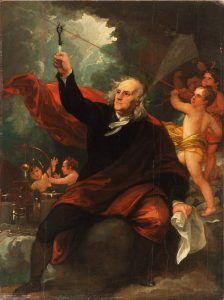
Fulton produced two full sets of drawings depicting these plans, accompanied by copious written specifications containing exhaustive financial calculations, as well as high-flying speculations on the political economy and the potential for his invention to finally and permanently end maritime warfare. Yet for all these expansive details and exhaustive speculations, Fulton’s inventive process is entirely obscured in the 1806 West portrait. The artist has instead placed the proximate cause of the inflammation at a distance, mired in smoke and shadow. In doing so, he has appropriated the language of the nocturne, used repeatedly by his contemporaries to describe the sublime scenes and terrifying ravages that industrialization had begun to enact within the English landscape (fig. 9). The effect is both awesome and mysterious, linking Fulton’s project, and his unique inventive genius, to newfound sources of industrial power; but in the process, he has also dissociated it from the physical instruments of invention. This portrayal of the technical imagination is all energy and no substance, capable of tearing through material constraints with terrifying force.
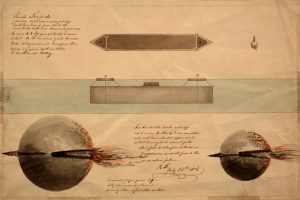
What motivates such a portrayal? Why this close association between innovation and destruction? The circumstances surrounding the production of the image provide one possible answer. West painted this portrait toward the end of Fulton’s second residence in England, which lasted from 1803 to 1806. Although he had left Pennsylvania for London in 1787 to pursue a career in painting, Fulton abandoned the professional life of an artist in 1797 and moved to France, hoping to interest the French government in his designs for canal navigation. It was in France that Fulton first developed his ideas for submarine and torpedo warfare, and the British government, hearing rumors of his successful tests of both, sought to lure him back to England with the promise of massive financial reward.7 Fulton returned to England in 1803, under the apparent belief that the government would pay out somewhere between £40,000 and £100,000 for his system of submarine warfare—presumably to keep it out of the hands of the French. The next three years would be spent in endless quarrels with the new administration of Prime Minister William Pitt.8 Pitt’s government failed to follow through on the remuneration Fulton believed he had been promised, and his correspondence is filled with complaints to the prime minister and his advisors, as well as preparations for the eventual arbitration that would decide whether his designs merited a government payout. Viewed against this backdrop, the portrait’s menacing portrayal of creativity seems no accident. One cannot help but read into its content a somewhat aggressive defense of an invention so dangerous that, according to fellow inventor Edmund Cartwright, it merited “total Annihilation,” and “cou’d scarcely be purchased at too great a price.”9
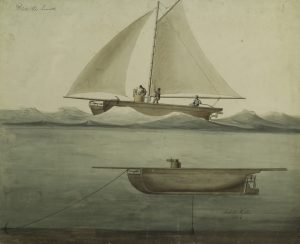
However, a second reading of the portrait moves beyond the narrow events of the engineer’s biography to engage a larger conversation amongst West’s contemporaries regarding the very nature of invention in the late eighteenth and early nineteenth centuries—a conversation that not infrequently invoked the metaphorics of fire. Joshua Reynolds, (1723–1792), in his sixth discourse to the Royal Academy, compared the process of invention to the burning of Corinth and the painter’s great store of images and ideas inherited from the classical tradition to base metals, fused by “the fire of the artist’s own genius” into a new and more perfect amalgam, akin to Corinthian brass.10 West himself would later pick up on this molten metaphor in his own address to the Royal Academy, in the process turning Reynolds’s lesson on its head. Commenting on the stultifying effect exercised by an overreliance on inherited traditions, West suggests:
More harm than good has therefore been done by the systems of those schools, which, having their own ideas of excellence, have brought every genius to assimilate with them . . . . [Genius] is there thrown, in fact, into a mould; it becomes like metal in fusion, and must take the impression for which the mould is prepared.11
Such metallurgical analogies evoke the work of yet another contemporary, namely the fire-lit scenes of labor depicted in the forge series by Joseph Wright of Derby (1734–1797)—images that were clearly designed to explore the relationship between painting and proto-industrial production (fig. 10). Wright’s images direct attention to the shared rhetoric of workmanship that threads through all three of these examples; even West, who uses the casting process to denigrate artistic conformity, posits the work of genius as something that is explicitly fabricated—something made.
It is this relationship between fire and fabrication that animates West’s portrayal of Fulton, linking it to contemporary debates over the nature of invention and, in particular, the relationship of invention to the practice of both art and science. As Lorraine Daston has argued, the eighteenth century saw a growing dissociation of the faculty of the imagination from the practice of science, and although derived from the same origin as the scientist’s increasingly preferred “facts,” terms like “manufacture” or “fabricate” acquired, in her words, “an evil odor of forgery and deception in addition to their root senses of construction.”12 Neither art nor science, engineering was fundamentally (and quite literally) an act of fabrication—the manufacture of a new object or set of objects where none had been before. It was both innovation (the act of making something new) and invention (in its Latin root of invenīre: to come upon, discover or find out).13 The figure of the engineer offered West a unique opportunity to explore this continuum from fact to fabrication. On one hand, the fire that illuminates the background of the portrait draws on the notion of invention as a process of scientific experimentation, testifying to the performance of an experimental trial and recording the observable, objective fact of its success. At the same time, his portrayal sublimates all of the details of Fulton’s creative process into a single explosive event—a metonymic depiction that makes reference to ancient associations between the transformative force of fire and the baser mechanical arts while also effacing any evidence of labor with its bright, white heat.14
In contrast to West’s strategy of metaphorical displacement, Fulton engaged with the problem of a technical imagination through the engineer’s medium of creation itself. In the late eighteenth and early nineteenth centuries, representation became a much larger component of the inventor’s activities. Drawings became necessary to secure future investment, to file for patent protection, to communicate with a diversifying workforce. In this manner, technical imagination grew increasingly dependent on the process of imaging, highlighting the fundamental imago at the Latin root of imagination’s etymology. Fulton’s apprenticeship as a miniaturist in America and later as an aspiring portraitist and history painter in London prepared him well for the descriptive duties of an inventor. Given such training, we should not be surprised to find his self-portrait in the midst of a copious set of drawings produced in support of his submarine and torpedo project—drawings that were incorporated as part of his testimony in negotiations with the British government.
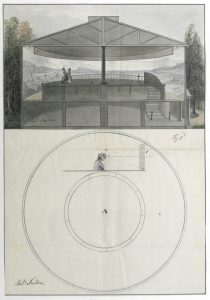
As a portrayal of artistic creativity and imagination, the image of Fulton encapsulated within the conning tower’s metal casing seems to belie the spontaneous, indeed combustible, creativity alluded to in the West portrait. Even upon closer inspection, the image of the artist-cum-engineer presented in Fulton’s drawing appears bound to a rigid and deterministic structure of perception, a model of the imagination more akin to West’s notion of the molded “metal in fusion” than the exuberant fireworks on display in his own work.15 The construction lines that trace the aperture of the submarine’s porthole appear to integrate the inventor into the furniture of his own machine, placing him subject to its mediation. A nearly contemporaneous patent application, filed by Fulton in France in 1799 and again in 1801, shows him to have been more than a little preoccupied with the mechanical mediation of sight (fig. 11). The figures in these drawings, like Fulton in his submarine, have been placed within a massive and fully immersive optical device, which (by design) delimits the possibilities for viewing and understanding their surroundings. As Jonathan Crary has argued, the panorama could only be consumed as fragments, ultimately resisting even cognitive assembly into an imagined whole.16 The same could be said of Fulton’s submarine as a viewing machine, with its conical glasses permitting only brief, vignetted portals onto the exterior world. How could this constricted vision ever be reconciled with West’s explosive visual metaphor?
And yet, upon further examination, these images may not be so diametrically opposed as they initially appear. Reading through the correspondence of Fulton and his friends, one does get a very real sense of his total identification with his “infernal machine.” As Fulton was in the midst of live trials of the submarine vessel, his patron Joel Barlow implored the engineer to consider, “that the machine of his body is better and more worthy his attention than any other machine he can make; that preservation is more useful than creation; and that unless he could create me one in the image of himself he had better preserve his own automaton.”17 Clearly, Fulton was not unfamiliar with the idea of himself as a biomechanical body, but in later correspondence with representatives of the British government, it seems this self-identification with his inventions was imbued with the same level of passion, indeed “fire” that appears in the West portrait. More than once in this correspondence, Fulton employs a strange, and somewhat threatening, slippage, in which he suggests, “Much experience has made me conscious of the power of the engines I possess, I am also sensible of my own resources and means of Action . . . I look to your Lordship and Lord Herrick for prompt justice. I demand it as my right and I never will Submit to plead for it as a favour.”18 Eliding the difference between explosive power and political pressure, these comments return a sense of urgency, immediacy, and dynamism to Fulton’s biomechanical hybridity.
This is not to claim that the images produced by Fulton and West are in any way identical—that they somehow offer us the same account of nineteenth-century invention. Yet, it is important to recognize the discursive territory they share. In seeking out the discourse of technics that underlies the emotive force of West’s depiction and in unearthing the frisson of violence betraying the cool rationality of Fulton’s mechanical drawing, we get closer to understanding the rapidly transforming world these men occupied. For both artists, the figure of the engineer supplied an opportunity to rehearse relationships between fact and fabrication, creativity and destruction, body and machine—relationships that were aggressively reorganized in the first decades of industrialization. Where differences arise is perhaps in each artist’s approach to the fundamental irony of combustion—its problematic alliance of creativity and destruction. Fulton appears to have openly embraced destruction as a necessary evil of creativity—after all, achieving peace through combat was the ostensible justification of his whole submarine project. However, West’s interpretation comes across with greater ambivalence. Dismissed as president of the Royal Academy in 1805 and reinstated in 1806, West was working on his portrait of Fulton at a critical moment of crisis in his career. Perhaps some sense of this crisis can be detected in his depiction of genius—the fires of genius as both an aggressive advantage and a self-destructive liability. If West’s engagement with creative combustion was mediated by his own anxieties, for Fulton, the self-destructive potential of genius was coolly accepted—a risk he knowingly took. And if Fulton’s eulogist is to be believed, it was this risk that ultimately caught up to the engineer in the end:
Like the self-burning tree of Gambia, he was destroyed by the fire of his own genius and the never ceasing activity of a vigorous mind. And O! may we not humbly hope that his immortal spirit, disembodied from its material incumbrance [sic], has taken its flight to the world of pure intellect, “where the wicked cease from troubling, and where the weary are at rest.”19
DOI: https://doi.org/10.24926/24716839.1534
PDF: EBE – Creative Combustion
Notes
- This phrase adorns the cover page of Robert Fulton, Torpedo War and Submarine Explosions (New York: Printed by William Elliot, 1810). ↵
- De Witt Clinton, A Discourse, Delivered before the American Academy of the Arts, (New York: T. and W. Mercein, printers to the Academy, 1816), 30. ↵
- This is to say the romantics’ conception of “the work of art as flowing from imagination, poesis, or genius, in relative freedom from rules,” accompanied by “a marked emphasis on originality” and an “animus against borrowing and imitativeness.” Richard Eldridge, et al. “Romanticism,” in Encyclopedia of Aesthetics, Oxford Art Online, Oxford University Press, accessed June 1, 2016, http://www.oxfordartonline.com.ezp-prod1.hul.harvard.edu/subscriber/article/opr/t234/e0450. See also, Hugh Honour, Romanticism, (New York: Harper and Row, 1979), 16–20; 247–54. ↵
- Lorraine Daston, “Fear & Loathing of the Imagination in Science,” Daedalus 134, no. 4 (1998): 17. ↵
- In his writings on electricity, Franklin argues that all matter contains some quantity of electrical “fluid” or “fire” which may be activated by exposure to an external source of electricity, such as lightning. As he writes, “common matter is a kind of sponge to the electrical fluid,” drawing in charge until it can contain no more and is “said to be electrified.” Benjamin Franklin, The Works of Benjamin Franklin: Containing Several Political and Historical Tracts Not Included in Any Former Edition, and Many Letters, Official and Private, Not Hitherto Published; with Notes and a Life of the Author, ed. Jared Sparks (Boston: Whittemore, Niles, and Hall, 1856), 227–28. ↵
- This technical information has been gleaned from Fulton’s drawings themselves. See William Barclay Parsons Robert Fulton Collection, MS18137, New York Public Library. ↵
- Evan Nepean to Admirals Lord Keith Sheerness, Admiral Montagu, Rear Admiral Montagu, Honorable Admiral Cornwallis and Admiral Sir Jonathan Colpoys, June 19, 1803, London, Box 2.3, William Barclay Parsons Robert Fulton Collection. ↵
- Biographical information on Fulton comes from Cadwallader D. Colden, The Life of Robert Fulton (New York: Kirk and Mercein New York, 1817); Alice Crary Sutcliffe, Robert Fulton and the “Clermont”: The Authoritative Story of Robert Fulton’s Early Experiments, Persistent Efforts, and Historic Achievements. Containing Many of Fulton’s Hitherto Unpublished Letters, Drawings, and Pictures (New York: The Century Co., 1909); Cynthia Owen Philip, Robert Fulton, a Biography (New York: F. Watts, 1985); Kirkpatrick Sale, The Fire of His Genius : Robert Fulton and the American Dream (New York: Free Press, 2001). Details of Fulton’s correspondence with the Pitt administration may be found in the William Barclay Parsons Robert Fulton Collection. ↵
- Edmund Cartwright to Lord Grenville, Woburn, October 6, 1806, in Robert Fulton, Edmund Cartwright, and W. Powell Jones, “New Light on Fulton’s Submarine,” Huntington Library Quarterly 4, no. 4 (July 1941): 495. ↵
- Joshua Reynolds, The Literary Works of Sir Joshua Reynolds: First President of the Royal Academy (London and Edinborough: T. Cadell, 1835), 397. ↵
- Benjamin West, A Discourse, Delivered to the Students of the Royal Academy, on the Distribution of the Prizes, December 10, 1792, by the President. Humbly Inscribed by Permission to His Majesty. (London: Printed by Thomas Cadell, printer to the Royal Academy, 1793), 12. ↵
- Fact, manufacture, and fabricate all derive from the same Latin root facere, meaning “to do or to make.” But as Daston notes, over the course of the eighteenth century, “fact” came to mean something “given by nature, not made by human art.” See Daston, “Fear and Loathing,” 18. ↵
- “Invent, v.,” OED Online, September 2015, Oxford University Press, http://www.oed.com.ezp-prod1.hul.harvard.edu/view/Entry/98960 (accessed December 01, 2015). ↵
- Writing in Politics of the activities proper to the citizen of a republic, Aristotle argues that “in the state which is best governed . . . the citizens must not lead the life of mechanics or tradesmen, for such a life is ignoble, and inimical to virtue.” Aristotle’s term βάναυσοι (banausoi), conventionally translated as “mechanics,” derives from βαῦνος (baunos) for furnace or forge and αὔω (auo), meaning to light a fire or make blaze. “Properly the designation of ‘those who work with the techniques of fire… . . .essentially blacksmiths, metallurgists, and potters,’” the term had by Aristotle’s time expanded to encompass the full range of manual or technical arts, without losing the taint of hard, physical labor embedded in its origins. Aristotle, Politics, VII, 9 1328 b33–a2; Leslie Kurke, Coins, Bodies, Games, and Gold: The Politics of Meaning in Archaic Greece (Princeton: Princeton University Press, 1999), 4. ↵
- West, A Discourse, 12. ↵
- Jonathan Crary, “Géricault, the Panorama, and Sites of Reality in the Early Nineteenth Century,” Grey Room 9 (Fall 2002): 21. ↵
- Charles Burr Todd, Life and Letters of Joel Barlow, LL. D., Poet, Statesman, Philosopher: With Extracts from His Works and Hitherto Unpublished Poems (New York: G. P. Putnam’s Sons, 1886), 179. ↵
- Robert Fulton to William Pitt, June 6, 1806, London, Box 1.1, William Barclay Parsons Robert Fulton Collection. ↵
- Clinton, A Discourse, 30. ↵
About the Author(s): Elizabeth Bacon Eager is at Harvard University.

